Up until recently, only one restored example of the distinctive ZIS/ZIL-127 bus, known for its spotlight on the forehead, ribbed aluminum sides riveted together, and plush seats akin to those in the TU-104 airliner, existed—and it was located in Tallinn. Now, a second one has made its debut in Moscow. This bus underwent a meticulous five-year restoration and has been transformed into a spectacular sight.
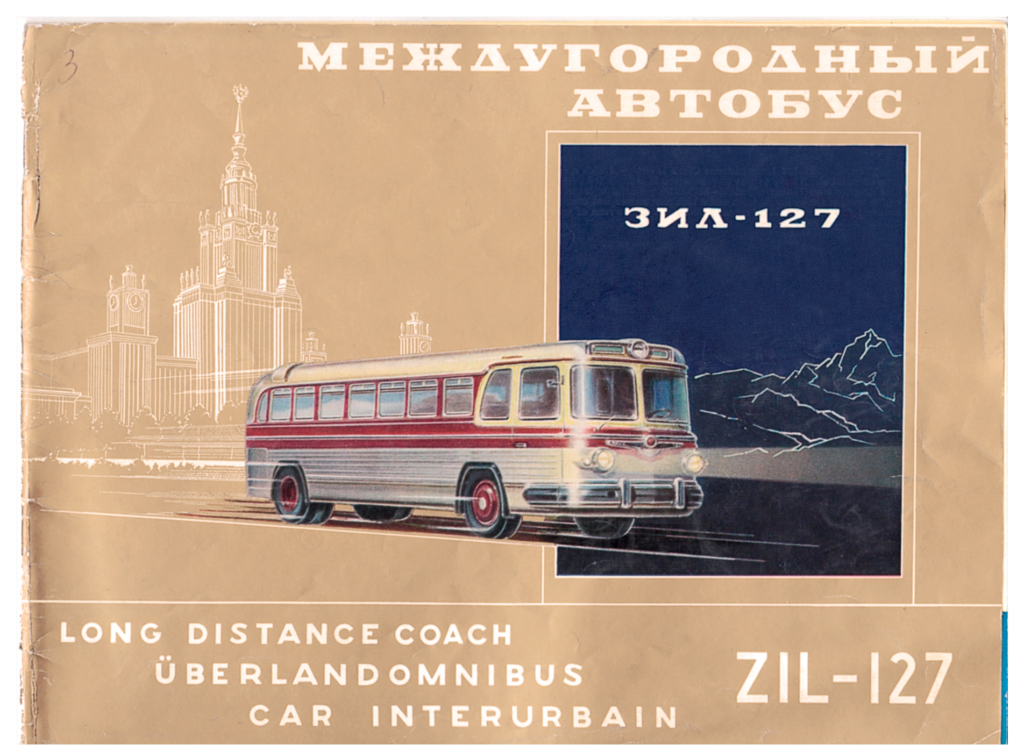
Back in the summer of 1956, the VDNH’s Engineering Pavilion (now known as Cosmos) began showcasing the first Soviet intercity liner, the ZIS-127, alongside other automotive marvels. Chrome details and the gleaming “ZIS Moscow” inscription on the nose undoubtedly had visitors imagining swift journeys to distant cities or luxurious resorts.

ZIL-127 at VDNKh, 1958 (photo pastvu.com)
On December 2, 1957, “Evening Moscow” reported on a new intercity bus route under the headline “Faster Than a Train”: “This morning at eight, a swift and comfortable ZIL-127 bus departed from Kursky Rail Terminal to Yaroslavl. It offers 32 soft seats with reclining backrests and all the necessary amenities for passengers, including effective heating, ventilation, radio, and a clock. Special compartments under the body accommodate luggage. The bus covers the over 280 kilometers to Yaroslavl in five hours, including stops, reaching speeds of 70—80 kilometers per hour on certain sections, while the train journey takes six hours.”
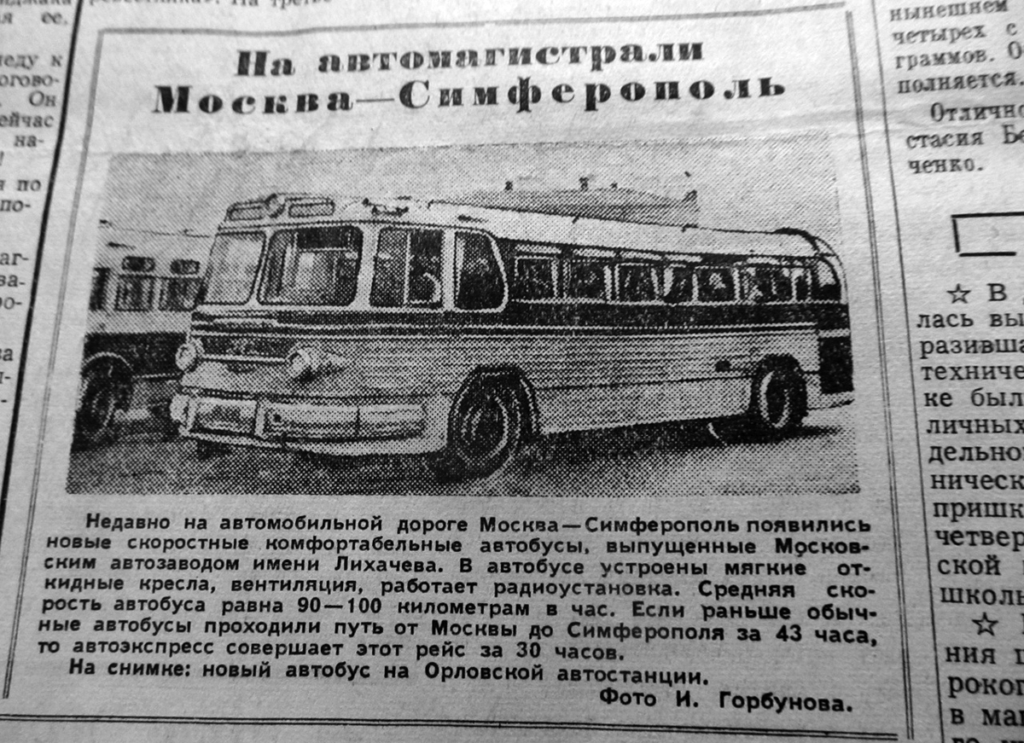
Note from the newspaper “Orlovskaya Pravda”
These express buses even outpaced their predecessors on the Moscow—Simferopol route, cruising at 90—100 km/h and completing the journey in 30 hours—a significant reduction from the 43 hours taken by the older ZIS-155 buses. They were the Soviet equivalent of the iconic American Greyhound buses known for coast-to-coast travel.
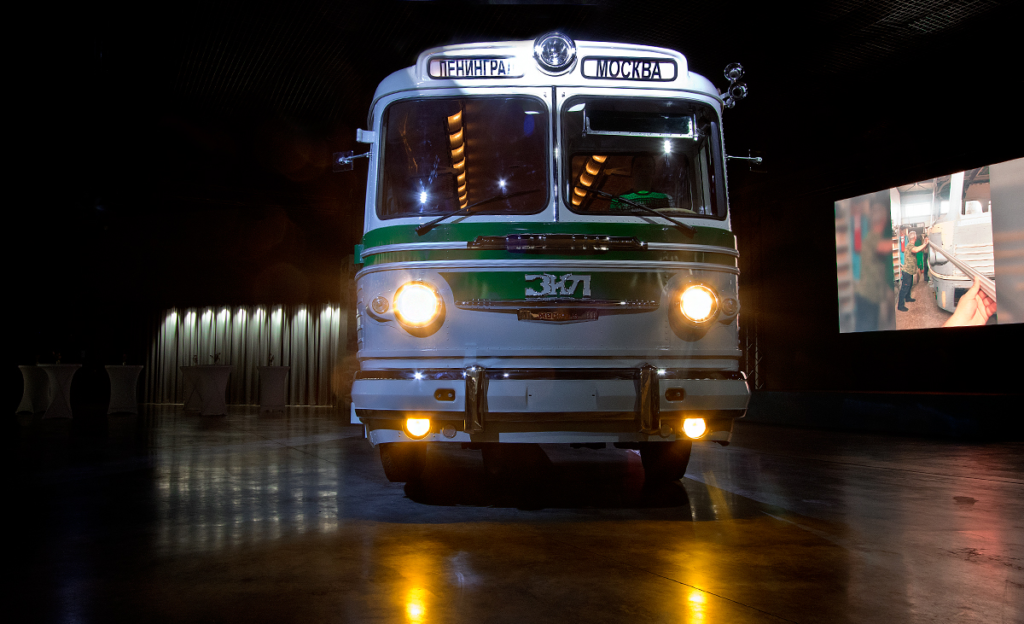
Nearly seven decades later, the ZIL-127 resurfaced at VDNH, not far from its original display location, now housed in the neighboring pavilion, home to the GON museum—a site that has evolved into a hub for retro automotive projects. The ZIL-127, with its unparalleled beauty and unique design, arguably qualifies as a bus with a special purpose.

This model introduced several innovations to Soviet buses: it was powered by the two-stroke YAAZ-206D diesel engine (unlike the diesel-electric city bus ZIS-154), featured power steering borrowed from a Lviv loader, and was equipped with a tube radio receiver, model A-5, also used in luxury ZIS-110 and ZIM cars.

Influenced heavily by the American automotive industry and specifically the ribbed-sided Greyhound buses, ZIS aimed to emulate American design aesthetics. The attention the ZIL-127 received was substantial, frequently making headlines in “Evening Moscow,” which chronicled not only the bus’s features but also the challenges it faced.
Before its launch into production, a designer humorously lamented in a May 5, 1955, verse, “I am completely unaware of the ZIS-127 brand. Without this brand, I have enough worries. I’m still on the edge, knowing nothing about where the equipment or the drawings are. So, don’t bother me!”
Despite promises of producing 100 buses in 1959, only 30 were actually manufactured.

On July 6, 1955, “Vechernyaya Moskva” reported on the start of serial production of ZIS-127 buses
On July 6, the factory commenced the mass production of the ZIS-127 for intercity travel and the ZIS-129 for urban use, although the latter was ultimately deemed a failure and never entered mass production.
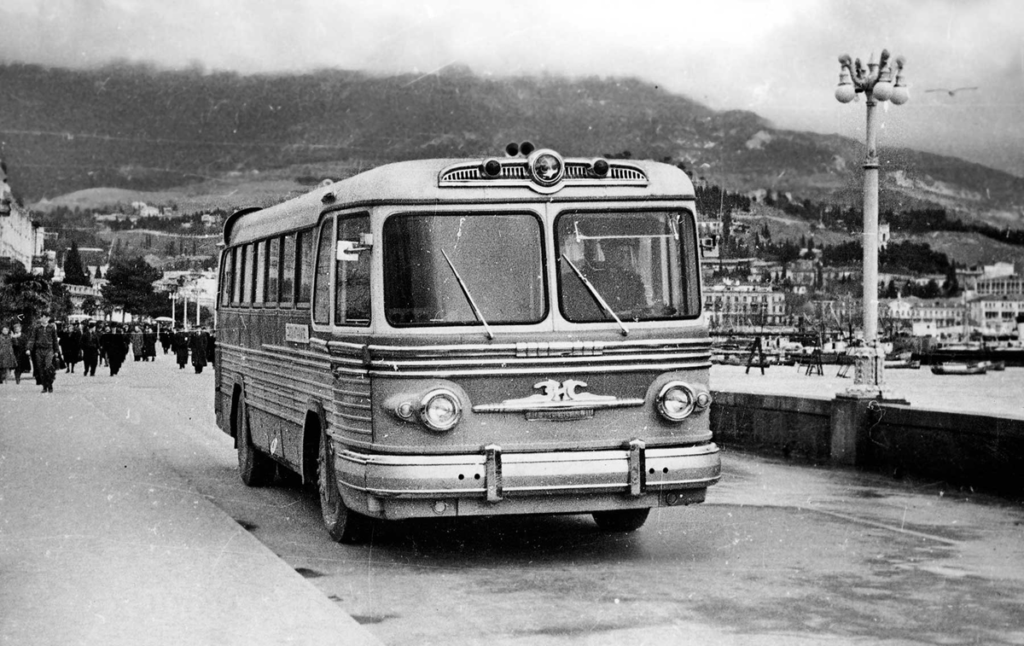
ZIS-127 on the Yalta embankment – apparently, one of the prototypes. (Photo pastvu.com)
Challenges continued as “Evening Moscow” on January 18, 1956, detailed the first batch of intercity ZIS-127 buses encountering significant rework due to inadequate design and documentation, which substantially increased production costs.

Photo from the magazine “Za Rulem”, No. 8, 1957
Driver dissatisfaction was vocalized on May 8, noting the bus’s capability to substantially cut travel time between Moscow and Kharkov to 17 hours from 22, yet drivers were penalized for speeding and had minimal rest due to stringent schedules.
Additionally, drivers requested to legalize the increased speed on the highway for the new model and to install signs requiring other vehicles to yield to buses “with a special signal”. Indeed, there was such a signal: silver horns on the roof—a mighty pneumatic horn C42, which was allowed to be used only on highways.

On the roof – a pneumatic signal and a horizontally stretched radio antenna. This type of horn was produced only for this model: it was distinguished by chrome plating and mesh inside the “horns”
However, by June 1, police were instructed to allow ZIS-127s to travel unhindered at higher speeds, and accommodations for driver rest were improved, significantly reducing travel times.

As of January 28, 1958, with the completion of the Moscow-Leningrad highway, it was announced that the route would be served by nocturnal, high-speed ZIL-127 buses. The journey, including stops, was timed at 14 hours with buses departing daily at 6:40 PM and arriving at 9:00 AM. The ticket price was set at 102 rubles and 60 kopecks, at a time when the average salary was 767 rubles.
By April 16, 1959, the TU-104-B airliner passengers on the newly inaugurated Moscow-Leningrad line began their journey not from Vnukovo Airport but from Revolution Square. Here, three freshly minted green-and-blue ZIL-127 buses awaited them—transferring them from one airplane seat to another.

Interior of the Tu-104 airliner
On June 7, 1961, advertisements for Mosttransagency’s routes to cities like Leningrad, Yalta, Rostov, Kharkov, Minsk, Pskov, and Novgorod touted the comfort of the ZIL-127 buses, noting they arrived at the boarding point 30 minutes before departure.
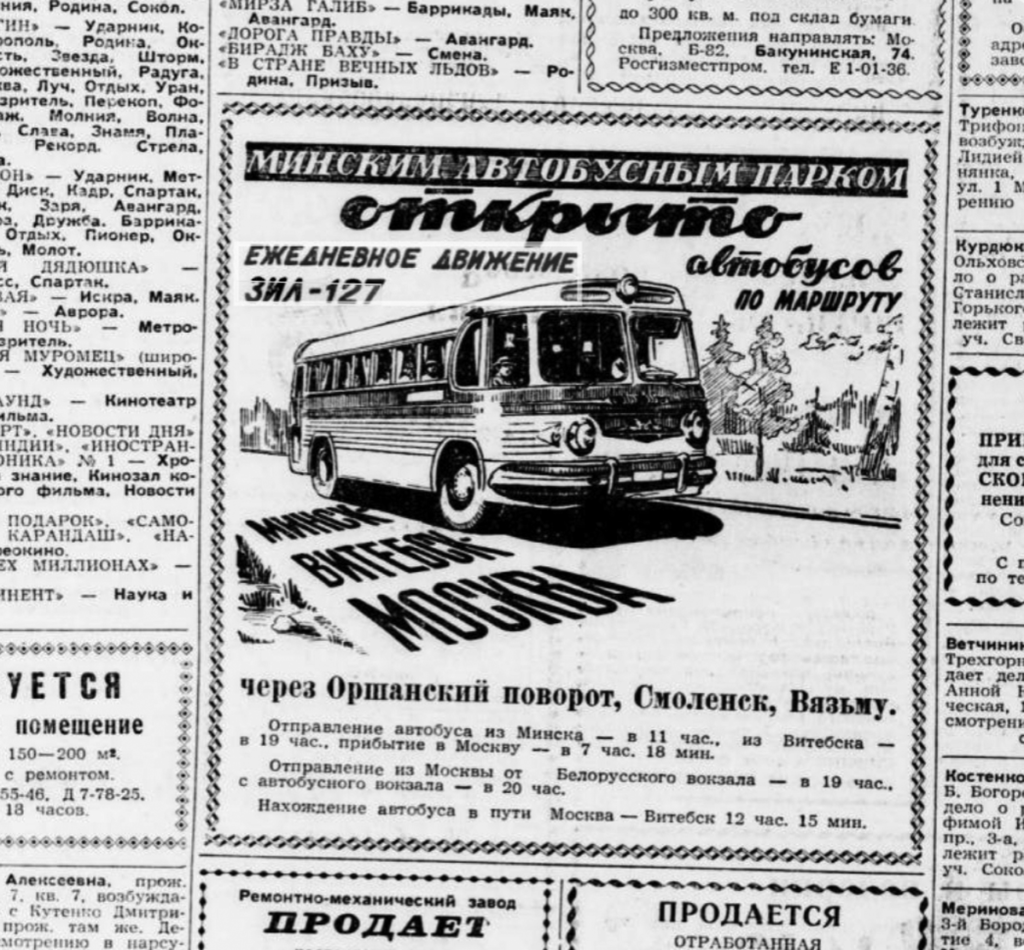
That same year marked the end of the ZIL-127 production line. Over five years, 851 units were manufactured before production ceased. The formal reason given was non-compliance with the Road Traffic Convention’s width limitations, which the USSR had agreed to—2.68 meters exceeded the 2.5-meter limit set by the convention.
However, the underlying reason was economic, influenced by decisions made by the Council for Mutual Economic Assistance, a Soviet-led economic group. To support Hungary’s automotive industry, it was decided to stop production of the ZIL-127 buses and instead, mass-import Hungarian Ikarus-55 Lux buses into the USSR.

A restored example from Tallinn before being sent to the “World of Buses” exhibition in Kolomna near Moscow (photo: wikipedia.org)
ZIL buses continued operations from the Moscow bus terminal until 1972. Today, only four examples of this iconic model survive within the former USSR, and not in full form. The only operational restored version was in Tallinn, having traveled to Russia for exhibitions. Another is believed to exist in Riga, though painted pink for a music video and its condition remains unknown. In the storages of Mosgortrans, a severely deteriorated body exists, stripped of its components.

This type of body is stored in the Mosgortrans storerooms (photo by Andrey Mikhailov, 2008)
The 1956 model discussed here had a somewhat fortunate post-service life. After decommissioning, it transported shuttle traders from Bataysk to flea markets in the capital during the 1990s, although it was far from its prime, resembling a weary trolleybus.




This is what the example from our article looked like in 1997, when it was transporting shuttle traders (Photo by Oleg Chernikov)
Eventually, this bus ended up at ZIL, exchanged for two trucks with hopes of restoration. That plan never came to fruition, and the bus remained idle for a decade.

This is what the bus looked like when it was parked at ZIL (photo from the VK group amozilclub)

Instead of these parts (here are only some of them), removed from the bus during the restoration process, new ones were made
When the factory faced demolition, this and other vehicles were rescued by enthusiasts from MSC-6, led by Kirill Molodtsov. Restoration efforts began in 2018, involving digital reconstruction of original designs and fabrication of new parts. The comprehensive restoration restored the bus to its original splendor, involving around 30 individuals.

A team of restorers…

…and its leader Kirill Molodtsov
Today, the bus resides under the arches of the Gon museum, its elegance unmistakable. A unique heavy door with a satisfyingly clicking lock invites visitors inside to an interior reminiscent of an aircraft, complete with luxurious “semi-sleeper” seats and a cockpit laden with vintage controls.
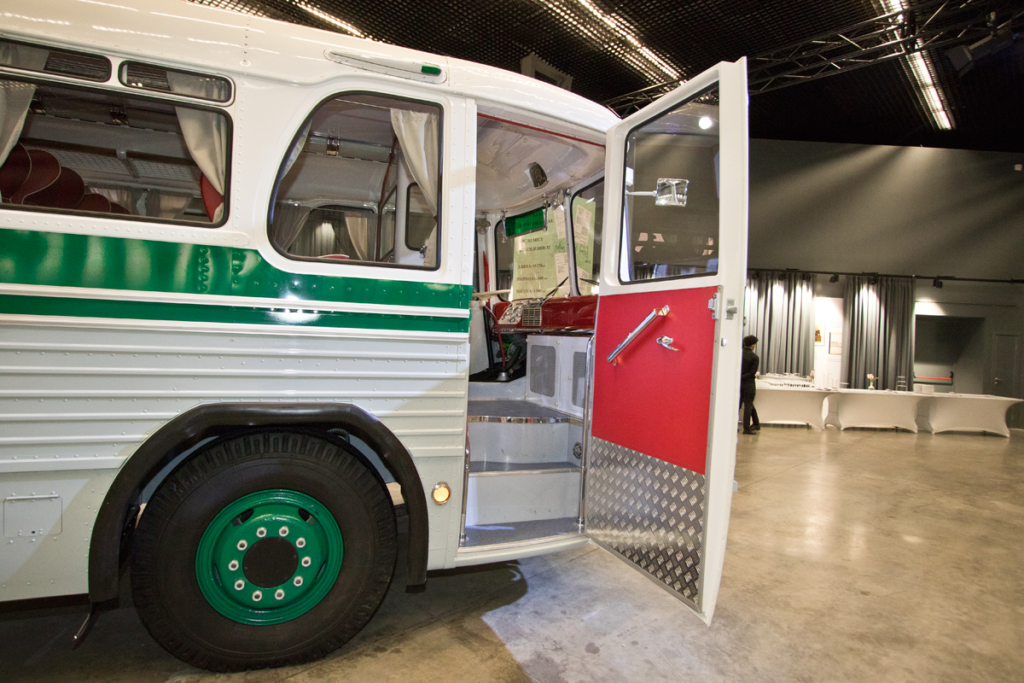
There is only one door – in the front, a hinged one
Behind the driver is practically an airplane cabin with two lines of ceiling lights, luggage racks, and plush “semi-sleeper” seats as they are called in the operation manual. I’ve never encountered such comfortable seats on buses before! You sit down and sink between the armrests, and if you pull the handle on the side, not just the backrest but the whole seat reclines into a semi-lying position. I’ll repeat, according to the restorers, the seats here are similar to those on the Tu-104.
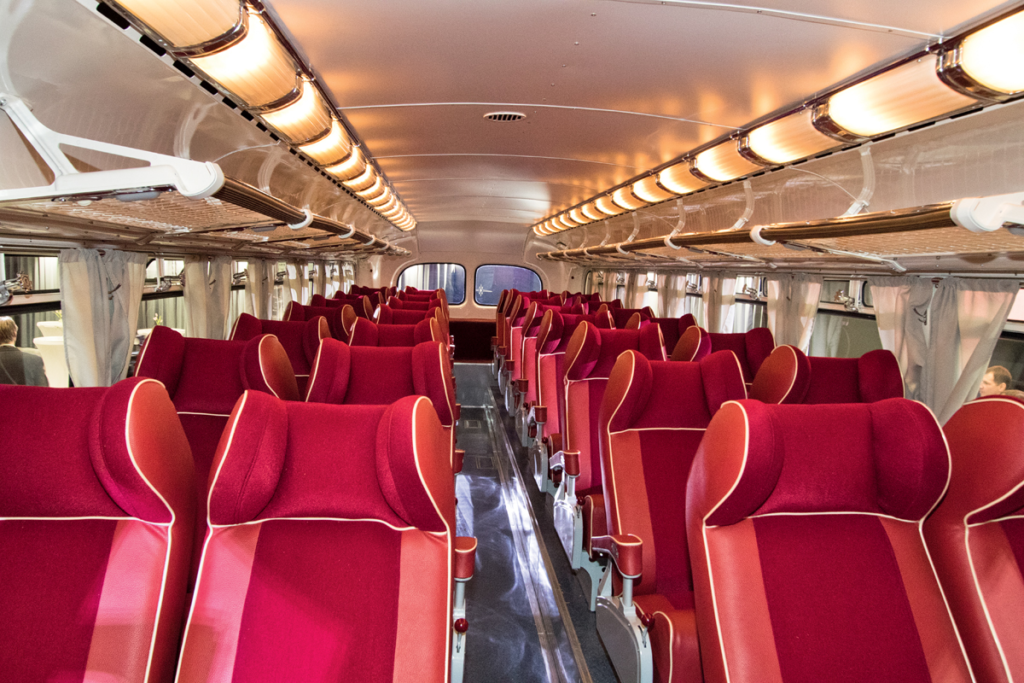
In the cabin 32 “semi-sleeper” chairs with plush upholstery
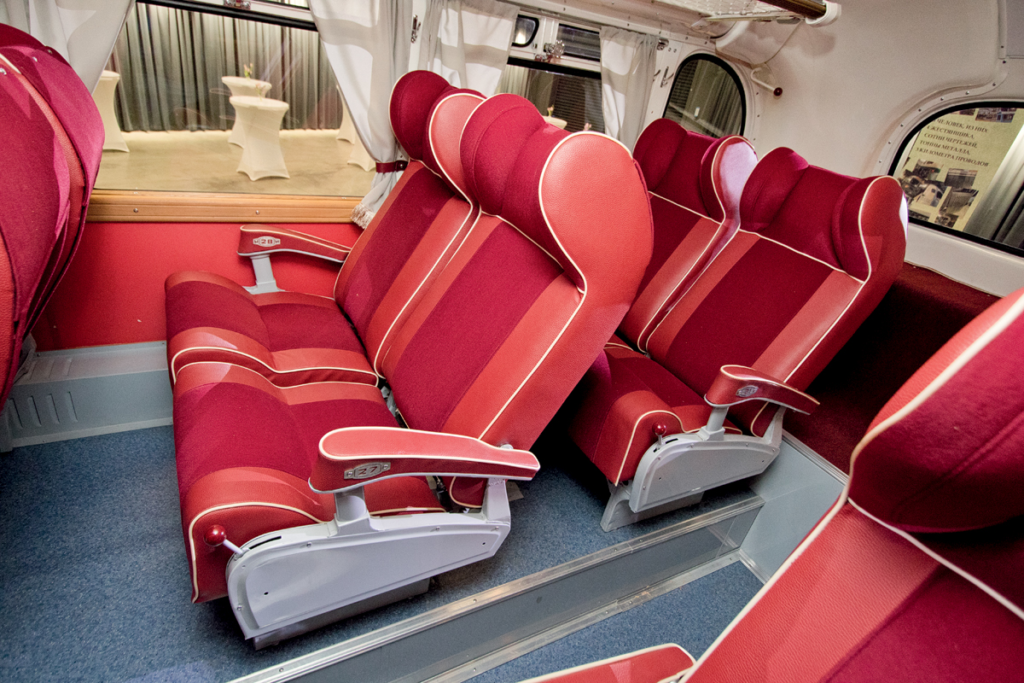
Luxurious chairs can be folded out
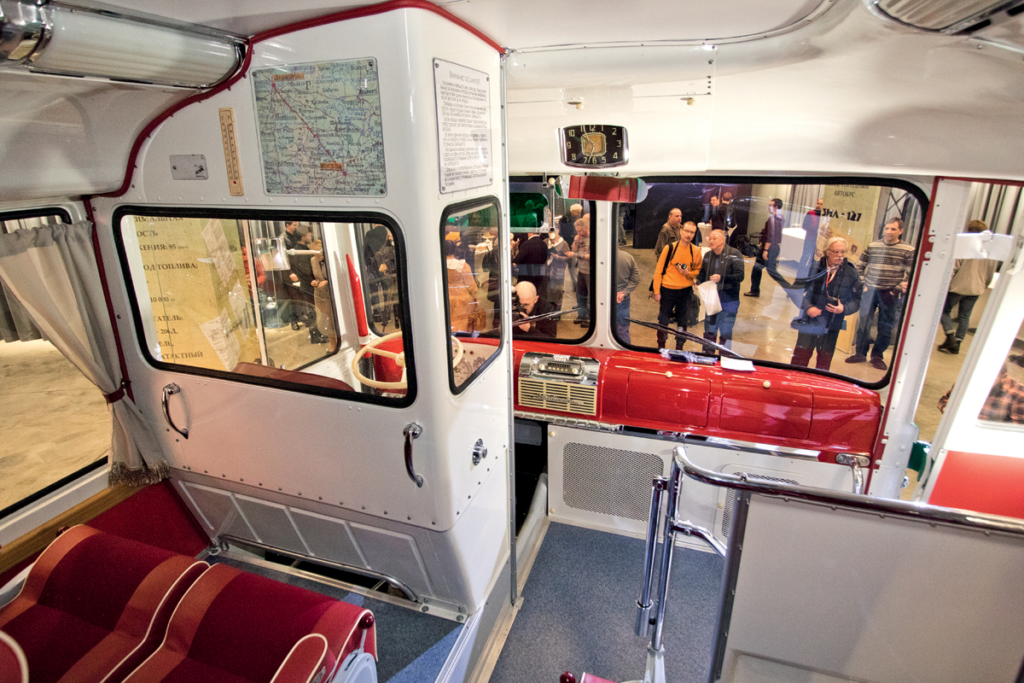
The driver sits in a semi-closed cabin

Authentic watches can now be bought at an online auction for 30 thousand rubles
And like on airliners, the windows did not open: they had only narrow vents so that passengers could not lean out while moving. Among the “delicacies” at the driver’s place are a sparkling handbrake lever and a long vertical pipe, which I initially mistook for a microphone stand—it turned out to be a warm air duct for defrosting the windows.

Rock and roll and boogie-woogie: the cabin interior resembles American cars of those years

The main dial is the speedometer with an unusual green zone
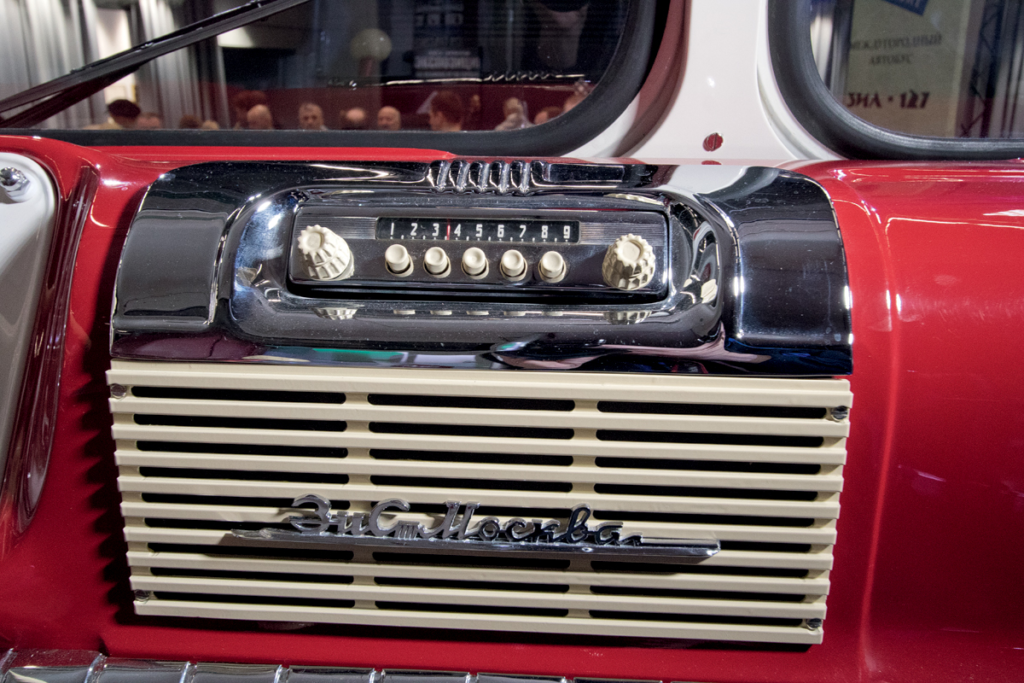
The A-5 tube receiver is the same as in the ZIS-110 and ZIM passenger cars

To the left of the driver is a sparkling handbrake, lighting and heating switches

This pipe is a windshield blower!
As you explore around and beneath the ZIS/ZIL-127 bus, numerous intriguing details come to light. The suspension is fully spring-based, known for its exceptional smoothness. The manual highlights an innovative feature: “plywood inserts between the leaf springs,” designed to extend the life of the suspension.
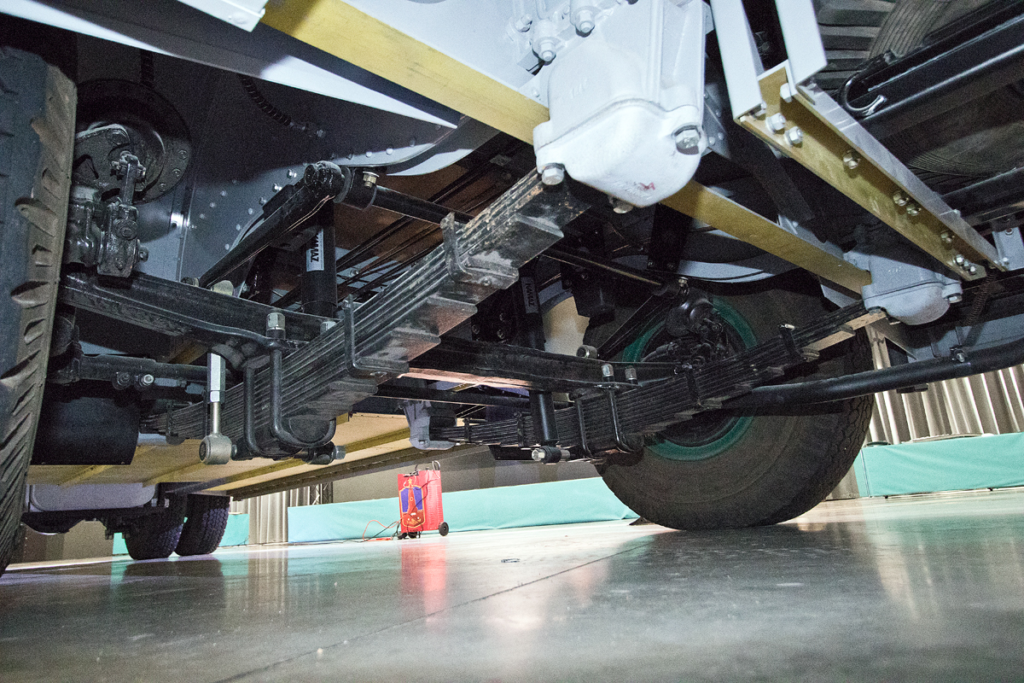
Leaf spring suspension: front…

…and rear
Another clever touch is hidden behind the fuel tank cover—a fuel gauge with an illumination button, a reminder to always check the fuel level during stops.
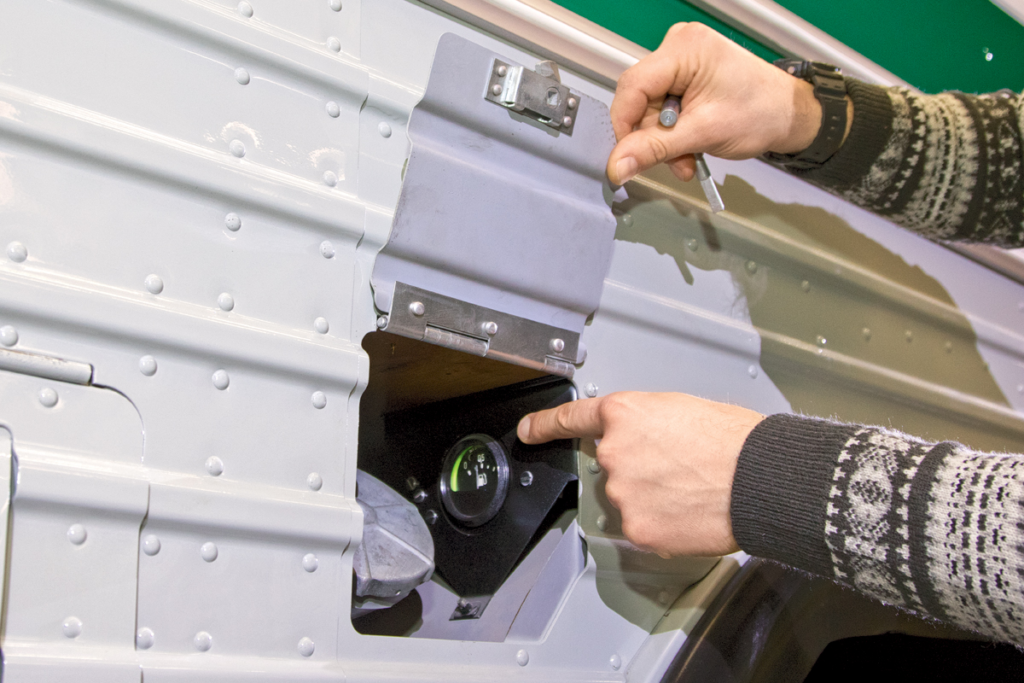
The fuel gauge with a backlight button is in the fuel hatch
The diesel engine and four-speed gearbox are transversely mounted in the engine compartment, showcasing some refined engineering. For example, the slits of the side “ear”-hatches are deliberately oriented: the left hatch leads to the radiator, the right to the engine belts. A smaller “ear” vent is strategically placed to cool the generator.

At the back — access to the power unit and its systems, on the side — luggage compartments and a compartment with batteries
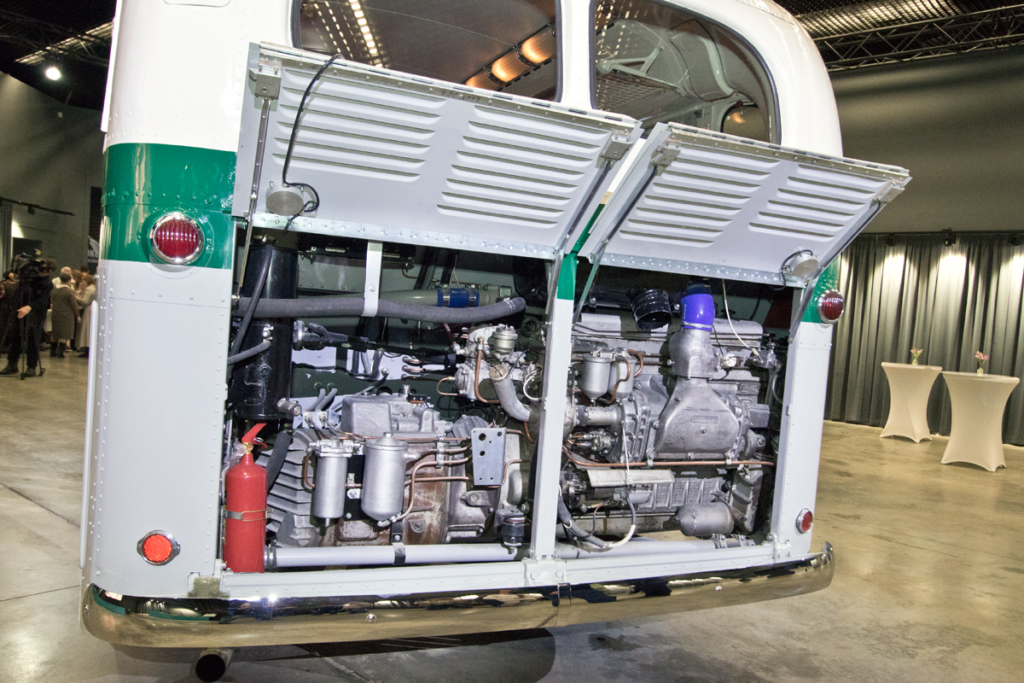
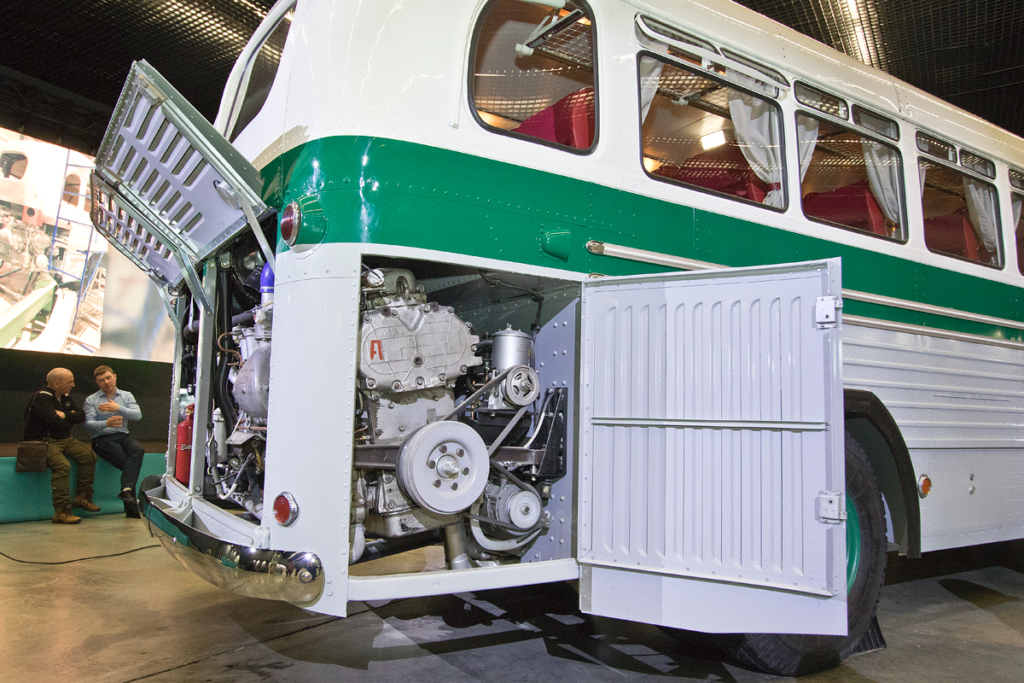
On the right — access to the belts

Judging by the plate, the engine, although not original, is authentic
According to the operation manual, before starting the engine at temperatures below minus 5 degrees Celsius, it required preheating by pouring in hot water, hot oil, or supplying steam—otherwise, starting it was impossible. It also cautioned that the diesel could potentially run away due to the jamming of the pump-injector racks’ control mechanism. In such instances, a valve would sharply cut off the air supply at the push of a button, preventing further complications. The Yaroslavl two-stroke engine was described as robust, with the manual stating matter-of-factly: “If the engine emits heavy smoke, it is not yet a reason for repair.”
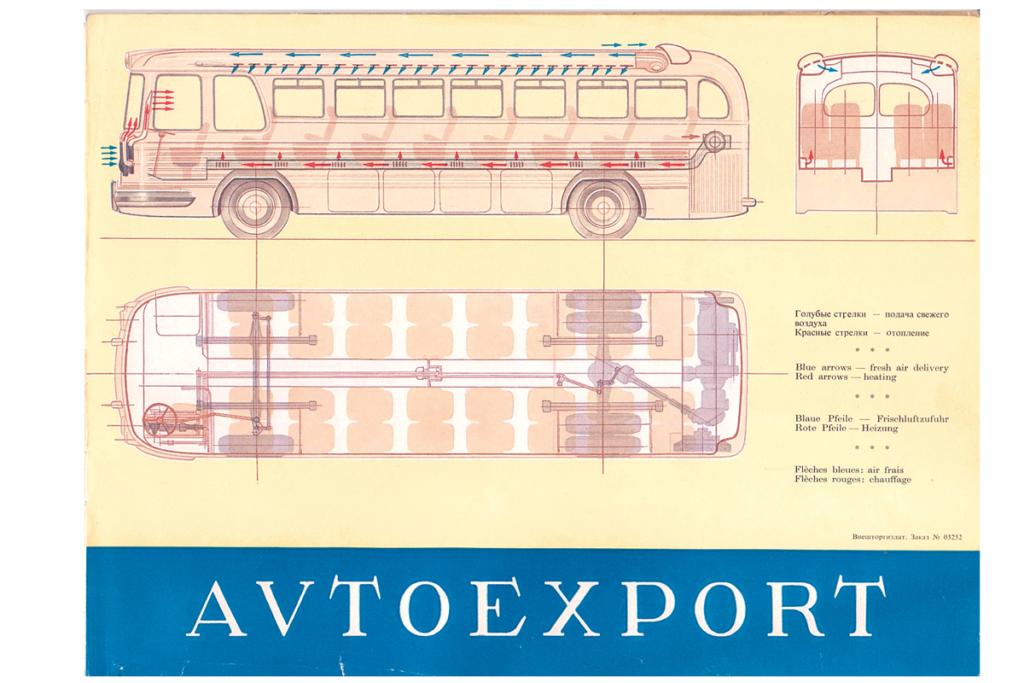
The diagram clearly shows the power unit, located transversely at the back, and the cardan shaft, running diagonally to the rear axle
Fuel efficiency was another aspect where the YAAZ diesel engine did not excel: with a full load at 70 km/h, the bus consumed 40 liters per 100 km according to its specifications, but Mosgortrans reported a consumption of 45 liters per 100 km, and likely more when pushed on highways. Maintenance schedules were stringent, requiring a TO-1 service every 2500-3000 km and a more comprehensive TO-2 every 10-14 thousand kilometers, which included changing the oil and completely flushing the engine’s lubrication system with a mixture of diesel, oil, and kerosene. A review of the spare parts catalog revealed a bewildering array of components, likening the bus to a land-bound aircraft, particularly in terms of body construction.

On the partition of the cabin — rules of conduct…

…the route of the liner and a thermometer
This raises a rhetorical question: Why was the restoration of such a unique vehicle achievable by private restorers, while Mosgortrans, with its substantial resources, neglected its specimen?

Judging by the preserved factory plate, the bus was manufactured in 1956. And the inscription “ZIL” on its nose is already later
After its unveiling at the GON museum, plans are in place for the “heavy luxury” to first be displayed at the ZIL museum in Sokolniki. At the end of May, the bus will be transported on a trailer to the retro parade in Saint Petersburg, where it is poised to shine as a star of the event, already operational. A new automotive transport museum is currently under development in Saint Petersburg, housing many vintage buses still in working order. The addition of the ZIL-127 to this collection would indeed be a magnificent sight!

This is how this article was created (photo by Denis Orlov)
Photo: Fedor Lapshin
This is a translation. You can read the original article here: Тяжелый люкс: рассказываем про уникальный отреставрированный автобус ЗИЛ-127

Published August 29, 2024 • 11m to read





